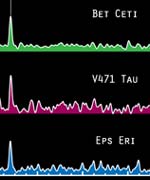
Image credit: Chandra
The V471 Tauri system comprises a white dwarf star (the primary) in a close orbit – one thirtieth of the distance between Mercury and the Sun – with a normal Sun-like star (the secondary). The white dwarf star was once a star several times as massive as the Sun. Chandra data on this system provide the best evidence yet that a star can be engulfed by its companion star and survive.
The illustration shows X-ray spectra made by Chandra’s Low Energy Transmission Grating Spectrometer of two individual stars and V471 Tauri: a red giant star (Beta Ceti, top panel), V471 Tauri, and a Sun-like star (Epsilon Eridani). The peak in the spectrum due to carbon ions is much smaller in the giant star than in the Sun-like star, whereas the carbon peak in V471 is intermediate between the two. These differences provide important clues to the different evolutionary histories of the stars.
Nuclear fusion reactions in the core of such a star convert carbon into nitrogen over a period of about a billion years. When the fuel in the core of the star is exhausted, the core collapses, triggering more energetic nuclear reactions that cause the star to expand and transform into a red giant before eventually collapsing to become a white dwarf.
The carbon-poor material in the core of the red giant is mixed with outer part of the star, so its atmosphere will have a deficit of carbon, as compared with Sun-like stars, as shown in the figure. If a red giant is part of binary system of closely orbiting stars, the evolution of the secondary star can be dramatically affected.
Theoretical calculations indicate that the red giant can completely envelop its companion star. During this common envelope phase, friction causes the companion star to spiral inward rapidly where it will either be destroyed by the red giant, or it will survive when much of the envelope is spun away.
If the companion star manages to survive, it will bear the marks of its ordeal in the form of contamination by carbon-poor material that it accreted while it was inside the red giant envelope. The X-ray spectrum of V471 Tauri in the middle panel shows just this effect – the carbon peak is intermediate between that of a Sun-like star and an isolated red giant star. The data indicate that about 10 percent of the star’s mass has been accreted from the red giant.
In the future the companion star can return the favor. It will expand and dump material back onto the white dwarf. If enough material is dumped on the white dwarf, it could cause the white dwarf to explode as a supernova.
Original Source: Chandra News Release
